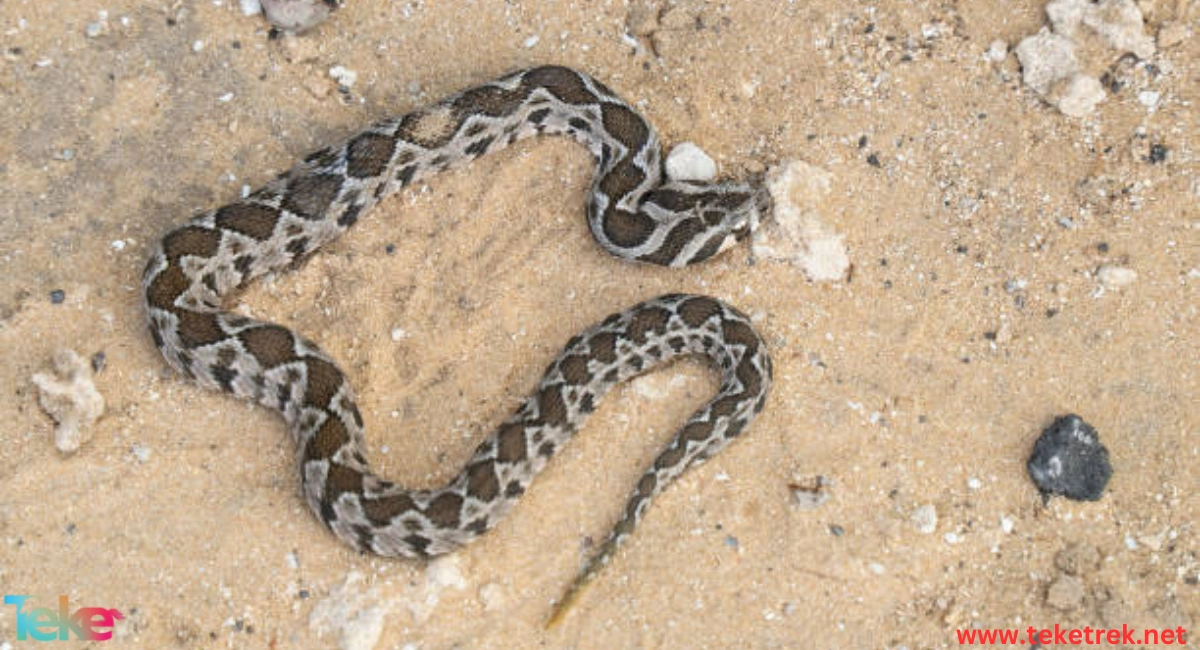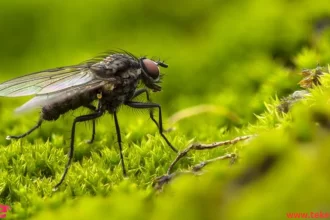The Palestine Viper scientifically known as Doboia Palestine, is a type of reptile belonging to the genus Cerastes in the family Viperidae.
The Palestine viper is known to be a venomous snake.
Let’s learn more about it from teketrek.
Facts about The Palestine Viper
The Palestine Viper is found in Palestine, Syria, Jordan, and Lebanon.
It is considered a deadly venomous snake, as its venom spreads in the body upon biting a human, and if not immediately treated, it can be fatal.
The Palestine viper is commonly found in open areas, abandoned places, and mountains.
It can climb trees and seeks winter shelter.
The Palestine viper can flatten its belly to slide through trees and can survive without food for up to two years.
It gives the impression of sleeping with its eyes open because its eyelids are transparent.
Males have two penis that alternate during mating.
The Palestine viper uses its tongue in a distinctive up-and-down movement to detect smells and interact with its surroundings.

The Palestine viper has several senses we can discuss
Vision: Vision in the Palestine viper varies from poor to difficult and moderate. Some snakes have sharp vision.
Smell: Smell is one of the strongest senses in the Palestine viper.
It relies on it to discover environmental secrets, detect incoming dangers, and locate prey.
However, this sense is not related to the nose like humans but to the forked tongue that tastes and smells simultaneously.
Hearing: The Palestine viper has two internal ears.
Through these ears, the snake can perceive vibrations in the ground and air. It can hear sounds of earth tremors.
The Palestine viper is considered very dangerous.
Its bite causes severe pain at the site of the bite, followed by swelling and discoloration.
The bitten area can turn black and ulcerate, potentially leading the victim into shock due to the bite.
In some cases, amputation of the affected limb or even death can occur.
Vipers with bright and light colors are more venomous.
Some species have deceptive characteristics towards their enemies.
The Palestine Viper specification
The length: Its length between 80 to 90 cm, with a maximum length of up to 130 cm.
The color: The Palestine Viper color is yellow with twisted dark lines from its tail to its head.
Its color varies between light brown, dark brown, and black.
The head: The Palestine viper has a triangular-shaped head.
The body, tail:
Its body is relatively wide, and its tail is short, with the female’s tail being shorter than the male’s.
The limbs: The Palestine viper does not have limbs.
The scales: The Palestine Viper on the head of the Palestine viper resembles those on its body in size.
What is the Palestine viper habitat?
This type of snake is found in Palestine, western Syria, northwestern Jordan, and Lebanon.
The Palestine viper can be found on the sides of houses, various buildings, and grassy areas.
The Palestine viper can also be found in many habitats around the Mediterranean Sea, including fields, forests, and agricultural areas.
What is the diet of the Palestine viper?
The Palestine viper feeds on rodents, birds, and reptiles. The Palestine viper hunts its prey by ambushing them.
The Palestine viper can climb to high places, which helps it feed on certain birds.
It is most active during the early hours after sunset and during the day when it is in popular wooded areas.
The Palestine viper primarily feeds on rodents, toads, and other small animals.
Reproductive stages of the Palestine viper
The mating season for the Palestine viper occurs between April and May.
The female Palestine viper lays around thirty eggs during August and July, laying them all at once.
The female Palestine viper incubates her eggs for approximately 39 to 60 days, depending on the temperature of the area she lives in.

How to distinguish the Palestine viper from other snakes?
To tell the Palestine viper apart from other snakes, such as the non-venomous Balkan whip snake, you should focus on its color and body structure. The Palestine viper is usually yellow with black, wavy stripes running from tail to head. Its body is stout with a short tail. In contrast, the Balkan whip snake, which is non-venomous, has separate dark circular spots on its back, is grayish-brown in color, and has a slimmer body than the Palestine viper.
How to respond if bitten by a Palestine viper
If you are bitten by a Palestine viper, you must first stay calm and go to the nearest hospital. In the meantime:
- Remove any jewelry or tight clothing from the affected area.
- Immobilize the bitten limb but do not apply a tight tourniquet.
- Keep the injured part still, avoid trying to suck out the venom or cut the wound, and keep the patient as calm and comfortable as possible.
The Palestine viper’s role in ecological balance
The Palestine viper plays a vital role in maintaining ecological balance in Palestine as a natural regulator of pests and rodents, preventing the spread of diseases and agricultural damage. Despite being venomous, its presence is crucial for the ecosystem and it forms an integral part of the food chain by:
- Regulating rodent populations: The Palestine viper preys on rodents like mice and rats, reducing their numbers and preventing disease transmission to humans and animals.
- Controlling insects: The viper helps reduce populations of harmful insects that damage crops, supporting agricultural production.
- Part of the food chain: The Palestine viper contributes to the ecological food web by preying on other animals, influencing the distribution and abundance of various species.
- Preserving biodiversity: Its presence reflects the health of the ecosystem and helps maintain biodiversity.
- Medical research use: The venom of the Palestine viper is used in producing medications and antivenoms, highlighting its scientific and medical value.
Natural predators of the Palestine viper
The Palestine viper has several natural enemies, including hawks (especially the short-toed snake eagle), monitor lizards, hedgehogs, leopards, cats, and other snakes like cobras and pythons. These predators often feed on Palestine vipers, and some have even developed resistance to its venom.
How to avoid encountering the Palestine viper in nature
To avoid encounters with the Palestine viper:
- Be cautious and walk in well-lit areas.
- Wear protective clothing.
- Avoid areas dense with grass and rocks.
- Drain damp areas.
- Do not leave food waste in the open.
- Use a walking stick.
- Do not approach snakes.
- Remove potential food sources for snakes.
- Use natural snake repellents.
Does the Palestine viper pose a threat to human life?
Yes, the Palestine viper is venomous and can cause severe harm or even death if the victim does not receive proper treatment after a bite.
When is the Palestine viper most active?
The Palestine viper is most active during the day and the early hours after sunset, especially in grassy and shrubby areas. Its activity increases in spring and continues through summer when warmer temperatures encourage it to search for food.
It is commonly found in wooded areas near homes but tends to avoid water surfaces or desert regions.
Is the Palestine viper’s venom used in medicine?
Yes, its venom is used in several medical applications, including the production of medicines and ointments, and in manufacturing antivenoms. Research is ongoing to explore other uses, such as developing powerful painkillers and alternatives to narcotics.
The impact of climate change on the Palestine viper’s habitat
Climate change negatively affects the Palestine viper’s habitat by raising temperatures and altering rainfall patterns. These changes can shift the snake’s distribution—pushing it to seek cooler, more humid environments, sometimes closer to populated areas. As a result, its activity and range may expand into new territories, including near human settlements.
The Palestine viper in folklore and mythology
In Palestinian folklore, the viper is a complex symbol with both positive and negative connotations. It may represent power, wisdom, and healing, but it is also associated with deceit and evil. In mythology, the snake often symbolizes hidden forces, the underworld, and betrayal.
FAQs about The Palestine viper
What distinguishes the Palestine viper from other snakes?
The main distinguishing feature of the Palestine viper is the W-shaped markings on its back, which are usually connected or separate.
Why is it important to conserve the Palestine viper?
The Palestine viper is part of the food chain in nature and contributes to the natural balance. Any disruption in this balance, whether through a decrease or increase in the species, can lead to disturbances in nature.
How poisonous is a Palestinian viper?
Bites may cause mild to severe local effects, shock & coagulopathy. All cases should be treated as potentially severe.Shock should be monitored for and Wo vigorously treated
What is The Palestine Viper behavior?
Palestine vipers are solitary and elusive snakes. They are nocturnal and primarily spend their time ambushing prey. When threatened, these snakes typically avoid confrontation and will emit hissing sounds as a warning before resorting to biting.
is The Palestine Viper rare?
The Palestine Viper, is common throughout the Mediterranean, in a wide range of habitats
According the IUCN Red List of Threatened Species, it is classified as LC (Least Concern). It has a wide distribution in our area.It is commonly found in man-made habitats and is widely recognized as the leading cause of snakebites.
Is Palestine Viper venomous?
Yes, it’s venomous and this venomous viper has a triangular head and grows up to 80cm long.
In conclusion, efforts must be made by all countries to conserve the Palestine viper as it plays a significant role in maintaining environmental balance.
References:
Wikipedia





